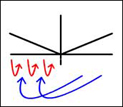“Neolithic Ancient Mesopotamia”
This video by Chirs Hasler on the Study of Antiquity and the Middle Ages channel explains what was happening in the Mesopotamia region during the Neolithic times (meaning at the time immediately before the rise of cities in the area.)
Following are points from the video:
Introductory information
— It is speculated the changes to the Earth’s climate during the Younger Dryas between 11,000 BC and 9,500 BC helped to prompt the “Neolithic Revolution” due to global temperatures dropping suddenly before stabilizing again.
— In the Fertile Crescent, agriculture, farming, metallurgy, and megalithic construction started taking place at this time with the associated sedentary lifestyles, leading to the development of villages, trade networks, social hierarchies, towns, and city-states.
— It is useful to distinguish between “northern” Mesopotamia and “southern” Mesopotamia.
Halaf Culture (6,000 BC to 5,400 BC)
— An important archeological site on northern Mesopotamia is known as “Catalhoyuk” which was occupied for six thousand years starting at 6,000 BC. It is one of the earliest sites from the Halaf Culture, existing in the “pre-pottery Neolithic.” It may have emerged as early as 6,500 BC.
— The Halaf Culture is associated with northern Mesopotamia and it is famous for its pottery, where they were able to achieve a better quality of ceramics due to the quality of clay that was used. The bowls, plates, and vases they created were decorated artistically and creatively.
— The Italian Archeologist Marcella Frangipane has written texts focusing on the archeology of the earliest Mesopotamian societies.
— The Halaf Culture was widespread throughout northern Mesopotamia but it was localized, where many small settlements spread throughout the region. Initially there was very little social hierarchy and there was a lot of communal outdoor activity in the villages such as food preparation, where the societies were egalitarian.
— Eventually the sites grew to be so large that it was necessary for a class-based society to be established, where a common law-code was eventually administered by an elite class.
Other Early Cultures of Northern Mesopotamia
— The Hassuna Culture (6,000 BC — 5,300 BC) also emerged in the northern region, where agricultural innovations were implemented such as the use of sickles for harvesting grains. Figurines and jars of food were buried with the dead.
— The Tell-Shemshara site in Iraq has remains of pottery that is associated with the Hassuna, but it also has links to the Tell Es-Sawwam site which is associated with the Samarra Culture (6,200 BC - 5,700 BC) further to the south.
— These sites practiced irrigation using the rivers.
Southern Mesopotamia
- The city-state of Eridu arose at about 5,400 BC, after the northern Mesopotamia cultures were firmly established. Previous to its existence, there was human activity in the area, which is known due to excavations of archeological sites at Tell Al-Wilayah in southern Iraq. The people were cereal producers who would have needed to make use of river water to grow their crops, but it is not known if they actually employed irrigation techniques or not. These people are considered to be the first at southern Mesopotamia, and they dominated the region for over 3,000 years as the “Ubaid” culture.
— The Ubaid culture is a modern label that refers to similar characteristics of the archeological sites in that region, pointing to a cultural connection between them. No written records exist from that time, but common styles of artifacts are used as indications of the connections between the regions.
— Pottery shows that a “transitional period” from the Halaf to Ubaid periods happened at around 5,500 BC, suggesting that the Ubaid either went on some sort of a rampage northward or perhaps a more gradual integration happened.
The Ubaid Period (6,500 BC — 4,000 BC)
— At around this time, Eridu became established as the first city, being a port city on the Persian Gulf at the time. The city grew quickly, utilizing mud-brick and reed houses, covering an area as large as 25 acres.
— Eridu developed into a class-based society during that time, which is supported by evidence from grave sites.
— Clay-fired pots and figurines exist from that time, giving clues about the spread of the culture from southern Mesopotamia to northern Mesopotamia. It is not known if relations between the northern and southern regions were friendly or not, however.
— Many of the settlements that were established during this time persisted for thousands of years.
— Uruk was one of the most important ancient Sumerian cities, originating during the Ubaid period with the earlier archeological levels dating back to 5,000 BC. It was further inland and it would have relied on irrigation to feed its population.
The Uruk Period (4,000 BC — 3,100 BC)
— There was no real “transition” between the Ubaid Period and the Uruk Period, however historians label them as such for convenience.
— At this time, more people started smelting copper.
— The site of Tell Brak in Syria was occupied before the Halaf culture even emerged, being over 2,000 years old by the time of the Uruk Period. It was a large city that covered over 100 acres.
— Cities during the Uruk period were expanding in size, and ceramics during that time became more plain and practical without having decorations. It is suggested that people were paid in grain during that time, where simple standard ceramic containers were filled to a certain level and distributed to the workers. [Note: Wouldn’t reusable burlap sacks of some type be more effective in that manner though? Perhaps the grain was simply sold in marketplaces in such ceramic containers instead, since reusability would not be as practical in that case. I’m sure it was much less resource-intensive to create a pot than it was to weave a sack back then.]
The Effects of Climate Change
— When the climate of Mesopotamia became more arid, it required increased irrigation which also increased the amount of salinization of the soil, eventually rendering large areas unsustainable.
— It is shown that many people migrated north up the river system in search of more fertile land.
— In the northern region of Chogha Mish in present-day Iran the first systems of accounting were established. “Accounting” is vital to history, as it is a systemized method of recording and keeping track of events. Accounting was necessary to keep track of information in order for a society to behave in a fair manner with its laws.
— Cuneiform writing on clay tablets was developed by the Sumerians at around 3,000 BC. It started out as pictograms that were written on the tablets using a sharpened stem of a reed.
Article Tree
| A Summary of the History of the World, in Videos |
| THE STONE AGE |
| Video: “Neolithic Ancient Mesopotamia” |








